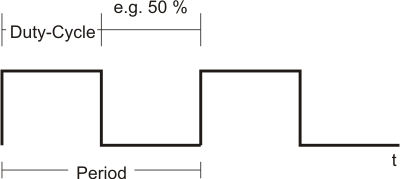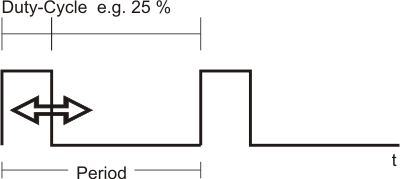IP/IE2512 Functioning
The special function module IP/IE2512 modulates a binary signal.
Either the pulse width or the frequency is changed. The periphery
side of the module electronics is electrically isolated from the
fieldbus or IP-Link. The cycle (base frequency) and the pulse/pause
ratio can be specified via 16-bit values in the process image of
the control.
The IP/IE2512 module occupies 6 bytes in the process image. The
IP/IE2512 mapping can be set via the control or via the KS2000
configuration software. In addition to PWM (pulse width modulation)
mode, the IP/IE2512 can be operated in FM (frequency modulation)
or, for stepper motor control, with pulse direction specification
(Frq-Cnt pulse mode). The default setting of the terminal is PWM
mode with a base frequency of 250 Hz and a resolution of 10
bit.
The module is temperature controlled. In case of over temperature the outputs are de-energized, an error bit in the STATUS Bytes is set an the error LED next to the M12 output is turned on (red).
Operating Modes
Operating Modes
The different operating modes of the module are set via the Feature register (R32). Three parameters are configurable:
- pulse width ratio
- pulse length
- frequency (period)
Depending on the type of operating mode, the parameters might influence each other.
Notice | |
Attention using the stepper motor functions(Frq_Cnt_PWM, Frq_Cnt_Impuls, Cnt_Cnt_PWM) only channel 1 can be used! |
PWM mode (frequency in the register, pulse width in the process data)
PWM mode
In PWMH and PWML mode, two channels can be operated. The operating mode and the period is identical for both channels. The ratio of duty cycle and period is specified via the process data (100 % duty cycle correspond to process data 0x7FFF). The period can be specified via register R2 during the operation. It is loaded after a system start-up from register R35 (SEEROM) and entered into register R2. Therefore R35 should be programmed in the applications default setting.

or

There are two different PWM frequency ranges that can be preselected via the Feature Register (R32).
|
Parameter |
Storage location |
|---|---|
|
period |
R2 (R35) |
|
duty cycle |
process data |
The frequency range is from 1 kHz to 80 kHz .
The period is programmed in R2 (R35). 1 Digit = 0,25 µsec. Attention: this value differs from setting the IP20 terminal KL2502!
The duty cycle is chosen by the process data, 0x7FFF equals 100 %, 25 % therefore is 0x1FFF.
|
Parameter |
Storage location |
|---|---|
|
period |
R2 (R35) |
|
duty cycle |
process data |
The frequency range is from 8 Hz to 1 kHz .
The period is programmed in R2 (R35). 1 Digit = 2 µsec. Attention: this value differs from setting the IP20 terminal KL2502!
The duty cycle is chosen by the process data, 0x7FFF equals 100 %, 25 % therefore is 0x1FFF.
Frq-Cnt PWM mode (pulse with ratio in the register, frequency in the process data)
Frq-Cnt PWM mode
|
Parameter |
Storage location |
|---|---|
|
pulse width ratio |
R36 |
|
frequency |
process data |
The frequency is specified in 8 Hz per digit via the process output data of the control. The control receives the number of periods that are output by the module as process input data. In this operating mode, the count direction is determined via the sign of the output data:
- 8 Hz corresponds to the value 0x0001
- -8 Hz corresponds to the value 0xFFFF (signed integer)
The frequency range is 8 Hz to 8 kHz.
The pulses are sent to output OUTPUT, the count direction to output UP/DOWN.
- ascending count direction corresponds to signal level VCC
- descending count direction corresponds to signal level GND
With rising edge of bit 0 in the control byte, the process input data is set to the value of the output data (process data mode, i.e. bit 7 of the control byte is 0). The pulse width ratio is specified via register R36.
Changes will be active only after a reset/power up.
Frq-Cnt pulse mode (pulse length in the register, frequency in the process data)
Frq-Cnt pulse mode
|
Parameter |
Storage location |
|---|---|
|
pulse width |
R37 |
|
frequency |
process data |
The frequency is specified with 8 Hz per digit via the process output data of the control. The control receives the number of pulses that are output by the terminal as process input data. In this operating mode, the count direction is determined via the sign of the output data:
- 8 Hz corresponds to the value 0x0001
- -8 Hz corresponds to the value 0xFFFF (signed integer)
The frequency range is 8 Hz to 8 kHz.
The pulses are sent to output OUTPUT, the count direction to output UP/DOWN.
- ascending count direction corresponds to signal level VCC
- descending count direction corresponds to signal level GND
With rising edge of bit 0 in the control byte, the process input data is set to the value of the output data (control byte in process data mode, i.e. bit 7=0). The pulse width is fixed for all frequencies and is specified via R37.
Changes will be active only after a reset/power up.
Cnt-Cnt PWM mode
Cnt-Cnt PWM mode
|
Parameter |
Storage location |
|---|---|
|
pulse width ratio |
R36 |
|
number of pulses |
process data |
|
period |
R35 |
The number of pulses is specified via the process output data. The control receives the number of periods that are output as process input data. The
- pulse width ratio is specified via register R36 and the
- period via register R35 (1 digit = 0.25 µsec).
The frequency ranges from 1 kHz to 32 kHz.
A rising edge of bit 0 in the control byte starts the pulse output. This can be re-triggered with every subsequent rising edge. The pulses are sent to output OUTPUT. Output UP/DOWN can be set via bit 2 of the control byte. In bit 0 of the status byte, the control receives the transfer and the simultaneous start of the pulse output as status information. Bit 1 of the status byte remains set as long as the output is active. Bit 2 of the status byte reports back the status of channel 1.
Pulse with ratio in the process data
Input format: Representation as complement on two (the integer
value "-1" is represented as 0xFFFF).
The ratio of duty cycle/period is specified with a maximum
resolution of 10 bit.
|
Process data |
Output value |
|---|---|
|
0x0000 |
0 % Duty Cycle |
|
0x3FFF |
50 % Duty Cycle |
|
0x7FFF |
100 % Duty Cycle |